AI-Assisted Identification of the Functional Residues of Ginsenoside Biosynthesis-Associated UGTs
Abstract
1. Introduction
2. Materials and Methods
2.1. Identification of Target Sequences
2.2. 3D Structure-Based Protein–Ligand Interactivity and Enzyme Catalytic Activity Assay
2.3. Mutagenic Analysis to Reveal Functional Amino Acid Residue
2.4. Data Visualization
3. Results
3.1. Identification of Potential Amino Acids of Functional Relevance in Ginsenoside Biosynthesis
3.2. Functional Amino Acid Residues from the Previous Study Mainly Alter Ligand Interactivity
3.3. Eight Amino Acid Residues with Functional Relevance
4. Discussion
Supplementary Materials
Author Contributions
Funding
Data Availability Statement
Conflicts of Interest
Abbreviations
| UGT | UDP-Glycosyltransferase |
| PPD | Protopanaxadiol |
| PPT | Protopanaxatriol |
References
- Leung, K.W.; Wong, A.S. Pharmacology of ginsenosides: A literature review. Chin. Med. 2010, 5, 20. [Google Scholar] [CrossRef]
- Hou, M.; Wang, R.; Zhao, S.; Wang, Z. Ginsenosides in Panax genus and their biosynthesis. Acta Pharm. Sin. B 2021, 11, 1813–1834. [Google Scholar] [CrossRef]
- Miao, L.; Yang, Y.; Li, Z.; Fang, Z.; Zhang, Y.; Han, C.-C. Ginsenoside Rb2: A review of pharmacokinetics and pharmacological effects. J. Ginseng Res. 2022, 46, 206–213. [Google Scholar] [CrossRef] [PubMed]
- Huang, W.-C.; Huang, T.-H.; Yeh, K.-W.; Chen, Y.-L.; Shen, S.-C.; Liou, C.-J. Ginsenoside Rg3 ameliorates allergic airway inflammation and oxidative stress in mice. J. Ginseng Res. 2021, 45, 654–664. [Google Scholar] [CrossRef] [PubMed]
- Wang, Y.; Mou, C.; Hu, Y.; He, Z.; Cho, J.Y.; Kim, J.H. In vivo metabolism, pharmacokinetics, and pharmacological activities of ginsenosides from ginseng. J. Ginseng Res. 2025, 49, 479–487. [Google Scholar] [CrossRef]
- Li, W.; Zheng, L.; Ma, X.; Xia, J.; Sheng, J.; Ge, P.; Yuan, Y.; Fan, Y.; Zhou, Y. The sugar moiety in protopanaxadiol ginsenoside affects its ability to target glucocorticoid receptor to regulate lipid metabolism. Bioorganic Chem. 2024, 153, 107885. [Google Scholar] [CrossRef]
- Chen, R.J.Y.; Chung, T.-Y.; Li, F.-Y.; Lin, N.-H.; Tzen, J.T.C. Effect of sugar positions in ginsenosides and their inhibitory potency on Na+/K+-ATPase activity. Acta Pharmacol. Sin. 2009, 30, 61–69. [Google Scholar] [CrossRef]
- Yan, X.; Fan, Y.; Wei, W.; Wang, P.; Liu, Q.; Wei, Y.; Zhang, L.; Zhao, G.; Yue, J.; Zhou, Z. Production of bioactive ginsenoside compound K in metabolically engineered yeast. Cell Res. 2014, 24, 770–773. [Google Scholar] [CrossRef]
- Wei, W.; Wang, P.; Wei, Y.; Liu, Q.; Yang, C.; Zhao, G.; Yue, J.; Yan, X.; Zhou, Z. Characterization of Panax ginseng UDP-Glycosyltransferases Catalyzing Protopanaxatriol and Biosyntheses of Bioactive Ginsenosides F1 and Rh1 in Metabolically Engineered Yeasts. Mol. Plant 2015, 8, 1412–1424. [Google Scholar] [CrossRef]
- Wang, P.; Wei, W.; Ye, W.; Li, X.; Zhao, W.; Yang, C.; Li, C.; Yan, X.; Zhou, Z. Synthesizing ginsenoside Rh2 in Saccharomyces cerevisiae cell factory at high-efficiency. Cell Discov. 2019, 5, 5. [Google Scholar] [CrossRef]
- Wang, Y.; Choi, K.-D.; Yu, H.; Jin, F.; Im, W.-T. Production of ginsenoside F1 using commercial enzyme Cellulase KN. J. Ginseng Res. 2016, 40, 121–126. [Google Scholar] [CrossRef]
- Liang, H.; Hu, Z.; Zhang, T.; Gong, T.; Chen, J.; Zhu, P.; Li, Y.; Yang, J. Production of a bioactive unnatural ginsenoside by metabolically engineered yeasts based on a new UDP-glycosyltransferase from Bacillus subtilis. Metab. Eng. 2017, 44, 60–69. [Google Scholar] [CrossRef] [PubMed]
- Altschul, S.F.; Gish, W.; Miller, W.; Myers, E.W.; Lipman, D.J. Basic local alignment search tool. J. Mol. Biol. 1990, 215, 403–410. [Google Scholar] [CrossRef] [PubMed]
- Camacho, C.; Coulouris, G.; Avagyan, V.; Ma, N.; Papadopoulos, J.; Bealer, K.; Madden, T.L. BLAST+: Architecture and applications. BMC Bioinform. 2009, 10, 421. [Google Scholar] [CrossRef] [PubMed]
- Edgar, R.C. MUSCLE: Multiple sequence alignment with high accuracy and high throughput. Nucleic Acids Res. 2004, 32, 1792–1797. [Google Scholar] [CrossRef]
- Waterhouse, A.M.; Procter, J.B.; Martin, D.M.A.; Clamp, M.; Barton, G.J. Jalview Version 2—A multiple sequence alignment editor and analysis workbench. Bioinformatics 2009, 25, 1189–1191. [Google Scholar] [CrossRef]
- Abramson, J.; Adler, J.; Dunger, J.; Evans, R.; Green, T.; Pritzel, A.; Ronneberger, O.; Willmore, L.; Ballard, A.J.; Bambrick, J.; et al. Accurate structure prediction of biomolecular interactions with AlphaFold 3. Nature 2024, 630, 493–500. [Google Scholar] [CrossRef]
- Grosdidier, A.; Zoete, V.; Michielin, O. SwissDock, a protein-small molecule docking web service based on EADock DSS. Nucleic Acids Res. 2011, 39, W270–W277. [Google Scholar] [CrossRef]
- Bugnon, M.; Röhrig, U.F.; Goullieux, M.; Perez, M.A.; Daina, A.; Michielin, O.; Zoete, V. SwissDock 2024: Major enhancements for small-molecule docking with Attracting Cavities and AutoDock Vina. Nucleic Acids Res. 2024, 52, W324–W332. [Google Scholar] [CrossRef]
- Liu, Y.; Yang, X.; Gan, J.; Chen, S.; Xiao, Z.-X.; Cao, Y. CB-Dock2: Improved protein–ligand blind docking by integrating cavity detection, docking and homologous template fitting. Nucleic Acids Res. 2022, 50, W159–W164. [Google Scholar] [CrossRef]
- Wang, J.; Yang, Z.; Chen, C.; Yao, G.; Wan, X.; Bao, S.; Ding, J.; Wang, L.; Jiang, H. MPEK: A multitask deep learning framework based on pretrained language models for enzymatic reaction kinetic parameters prediction. Brief. Bioinform. 2024, 25, bbae387. [Google Scholar] [CrossRef]
- Meng, E.C.; Goddard, T.D.; Pettersen, E.F.; Couch, G.S.; Pearson, Z.J.; Morris, J.H.; Ferrin, T.E. UCSF ChimeraX: Tools for structure building and analysis. Protein Sci. 2023, 32, e4792. [Google Scholar] [CrossRef]
- Chen, C.; Chen, H.; Zhang, Y.; Thomas, H.R.; Frank, M.H.; He, Y.; Xia, R. TBtools: An Integrative Toolkit Developed for Interactive Analyses of Big Biological Data. Mol. Plant 2020, 13, 1194–1202. [Google Scholar] [CrossRef]
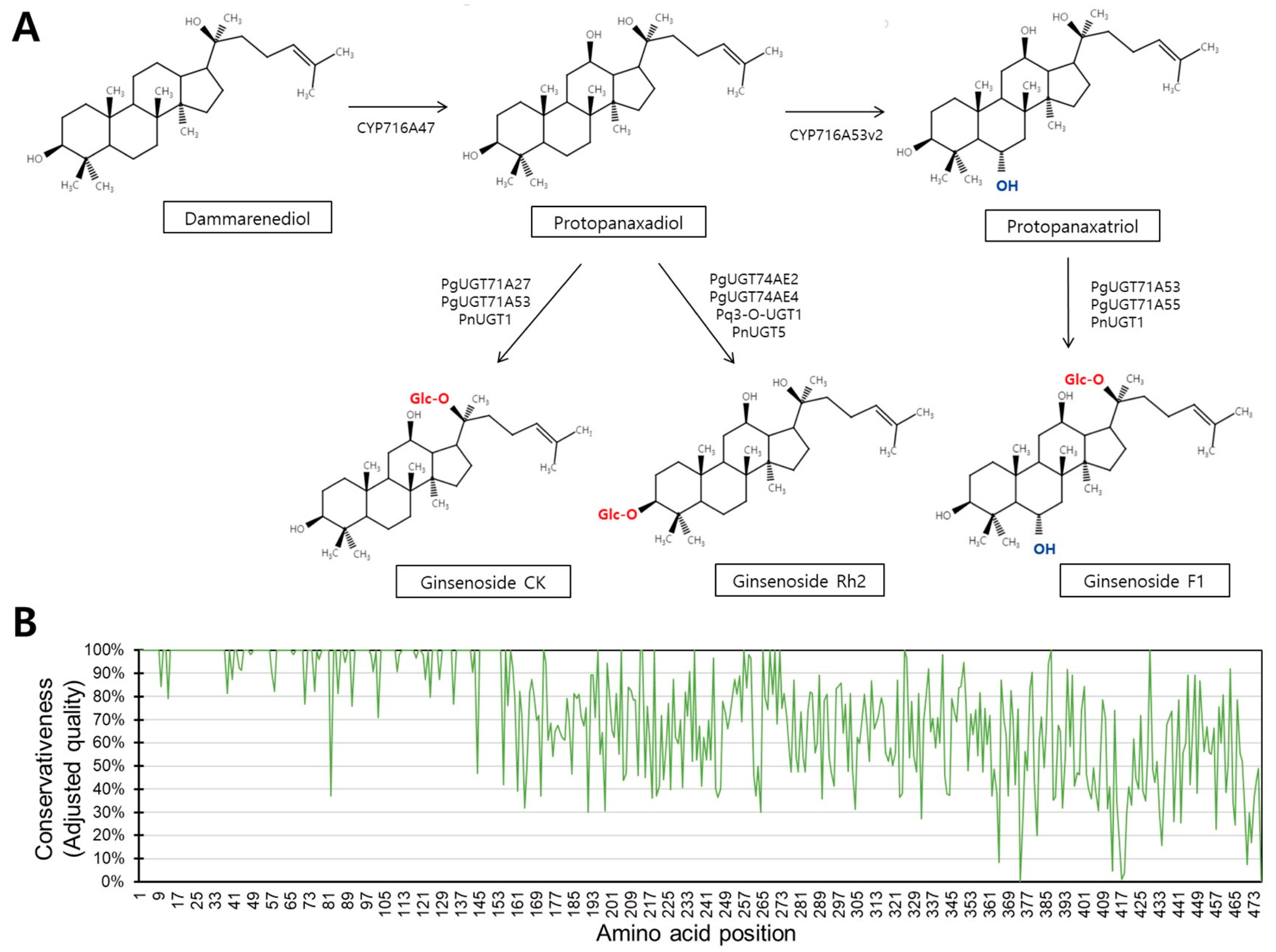
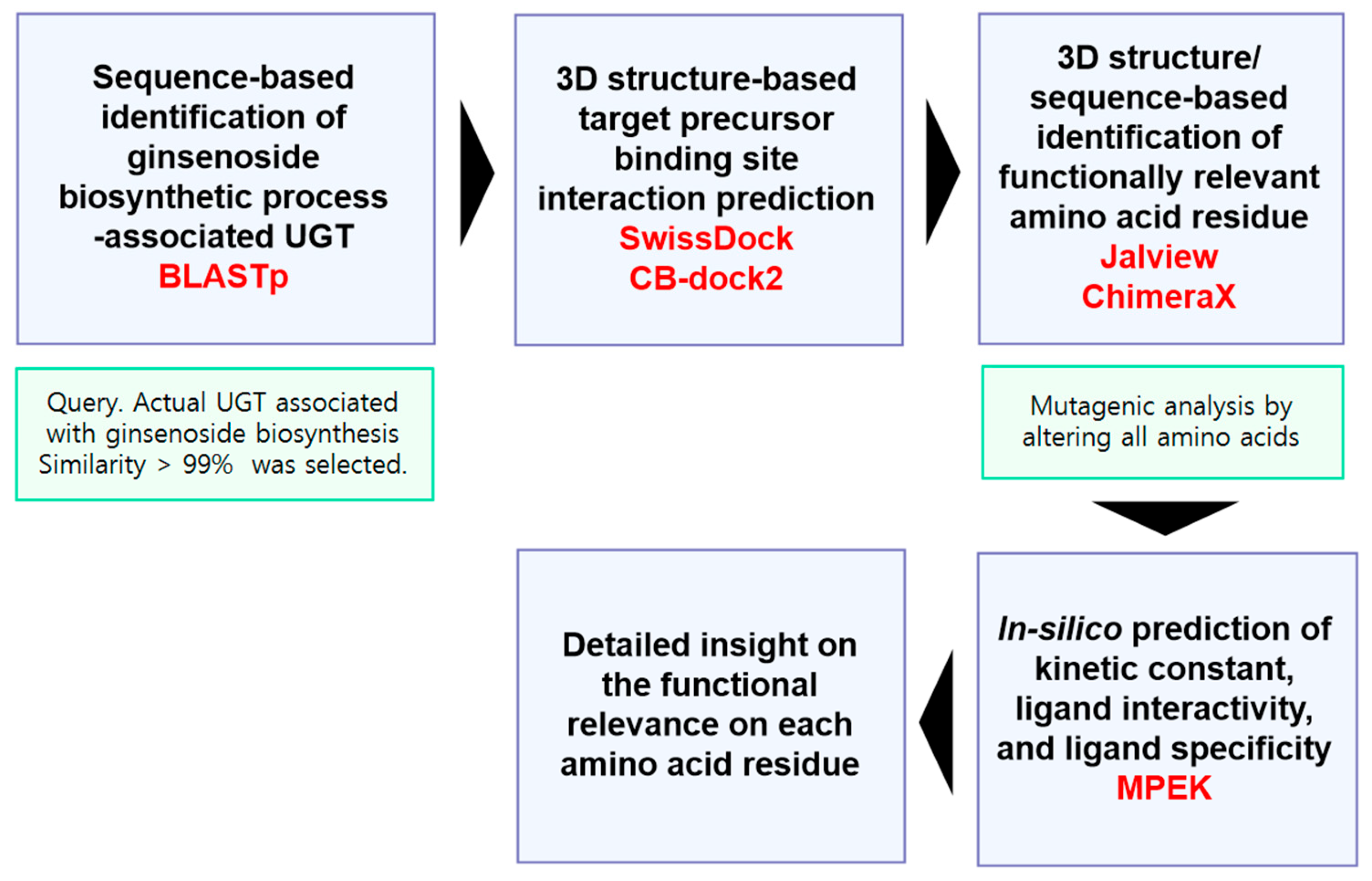
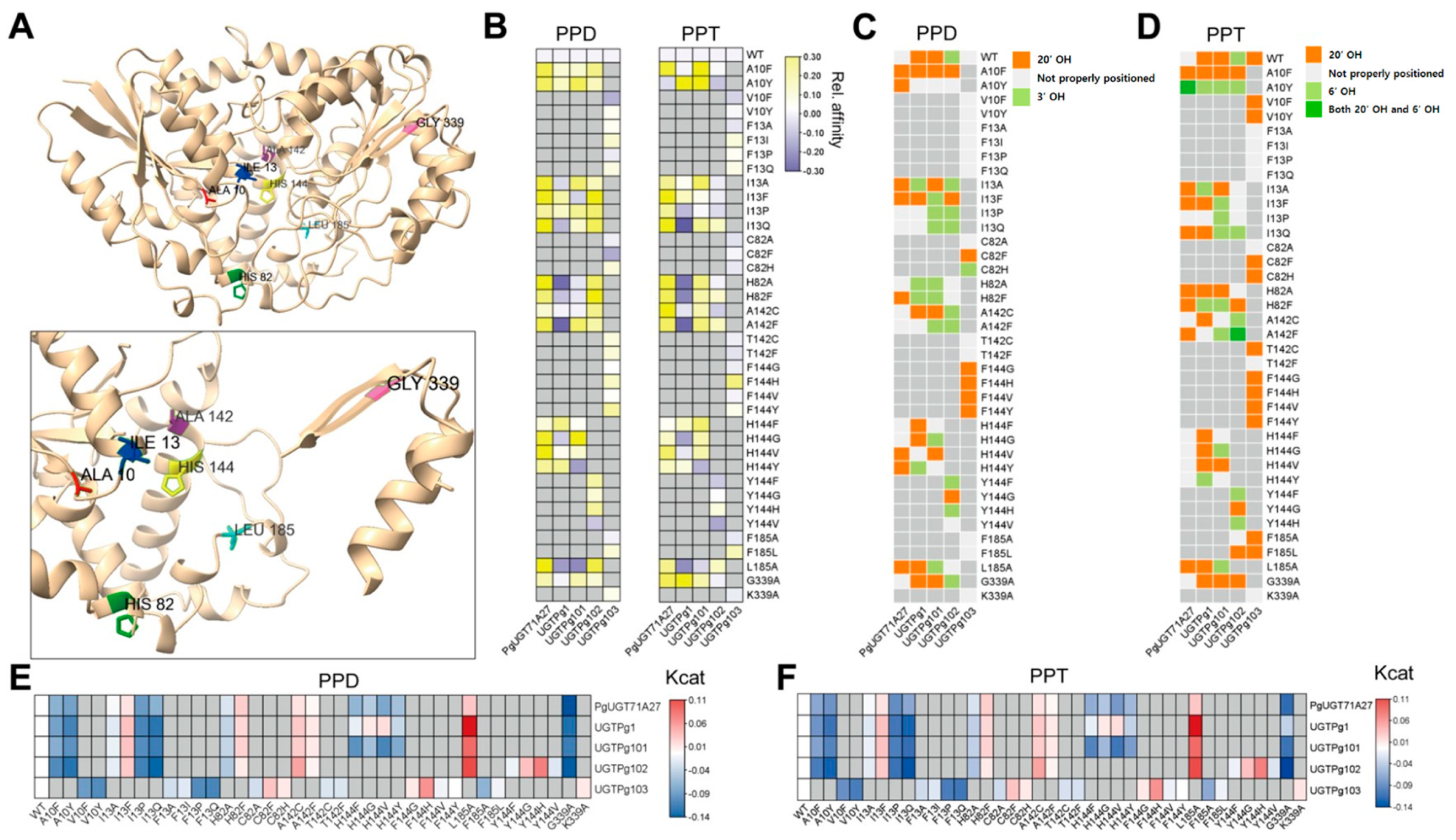
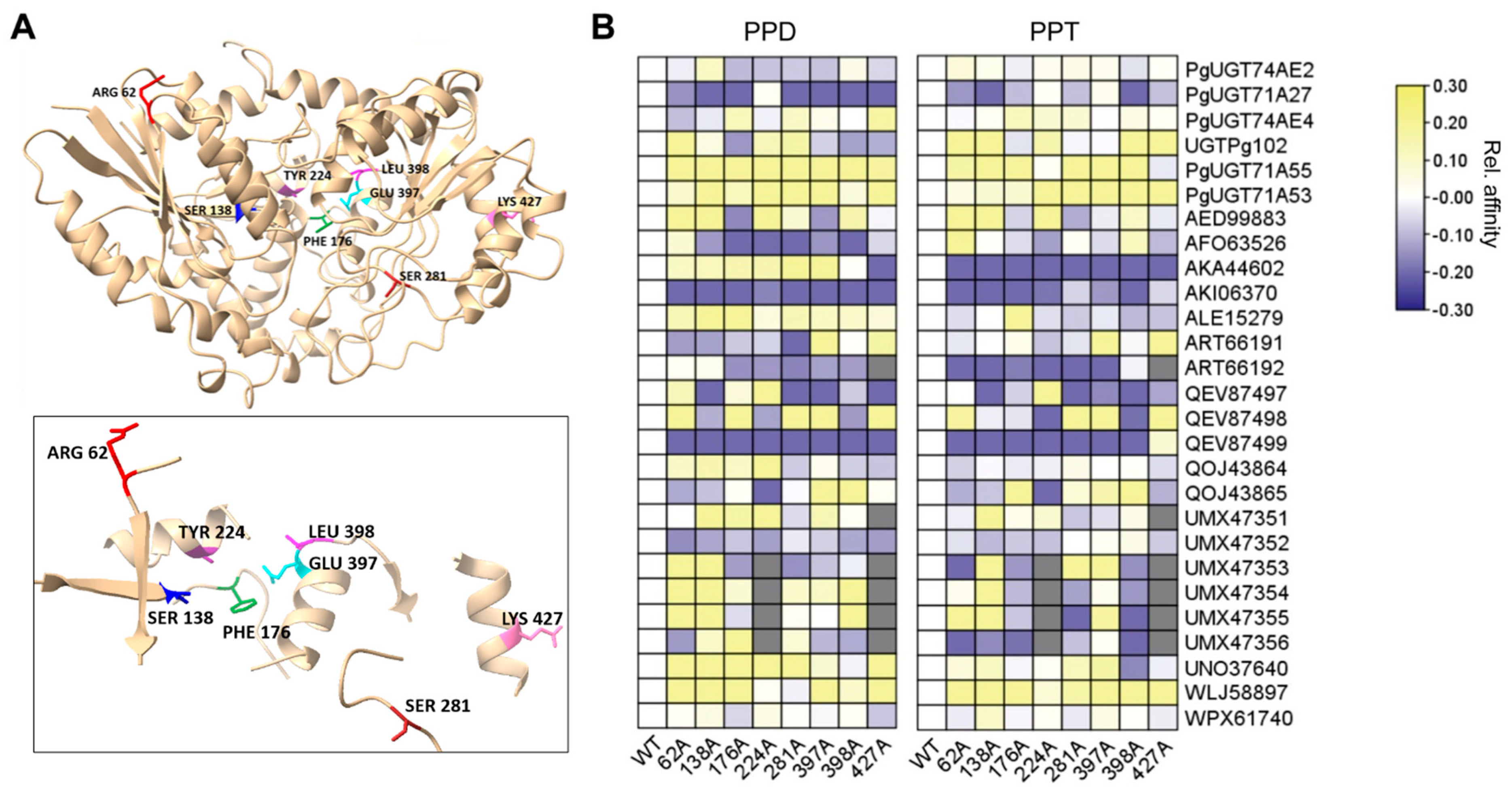

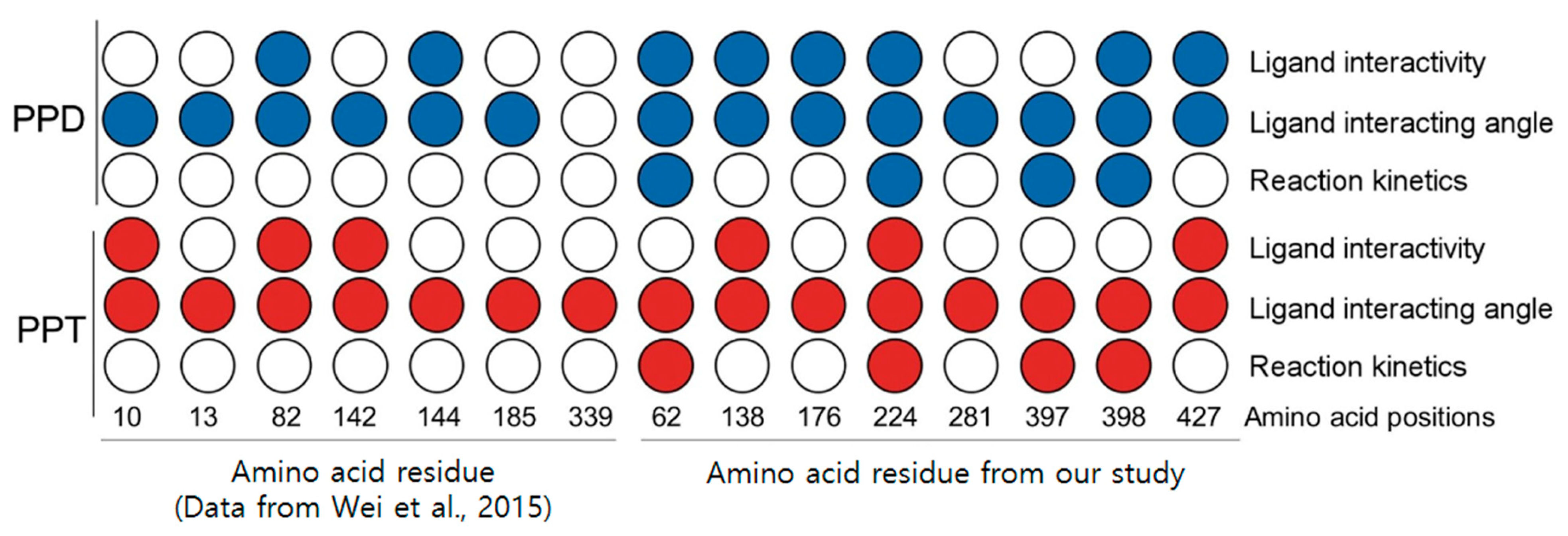
| Precursor | Product | Enzyme | UniProtKBID |
|---|---|---|---|
| protopanaxadiol | ginsenoside CK | PgUGT71A27 | A0A0A7HB61.1 |
| PnUGT1/UDP-glucosyltransferase | AFO63526.1 | ||
| PgUGT1/PgUGT71A53 | AIE12479.1/A0A068J840.1 | ||
| protopanaxatriol | ginsenoside F1 | PnUGT1/UDP-glucosyltransferase | AFO63526.1 |
| PgUGT1/PgUGT71A53 | AIE12479.1/A0A068J840.1 | ||
| PgUGT101/PgUGT71A55 | A0A0K0PVM5.1 |
| Accession Number | Description |
|---|---|
| A0A0A6ZFR4.1 | PgUGT74AE2 [Panax ginseng] |
| A0A0A7HB61.1 | PgUGT71A27 [Panax ginseng] |
| A0A0D5ZDC8.1 | PgUGT74AE4 [Panax ginseng] |
| A0A0K0PVL0.1 | UGTPg102 [Panax ginseng] |
| A0A0K0PVM5.1 | PgUGT71A55 [Panax ginseng] |
| A0A068J840.1 | PgUGT71A53 [Panax ginseng] |
| AED99883.1 | glycosyltransferase [Panax notoginseng] |
| AFO63526.1 | PnUGT1 [Panax notoginseng] |
| AKA44602.1 | UGTPg23 [Panax ginseng] |
| AKI06370.1 | glycosyltransferase [Panax quinquefolius] |
| ALE15279.1 | UDP-glycosyltransferase 3GT1 [Panax quinquefolius] |
| ART66191.1 | uridine diphosphate glycosyltransferase1 [Kalopanax septemlobus] |
| ART66192.1 | uridine diphosphate glycosyltransferase2 [Kalopanax septemlobus] |
| QEV87497.1 | Pq3-O-UGT1 [Panax quinquefolius] |
| QEV87498.1 | UDP-glycosyltransferase [Panax quinquefolius] |
| QEV87499.1 | UDP-glycosyltransferase [Panax quinquefolius] |
| QOJ43864.1 | UDP-glycosyltransferase [Panax notoginseng] |
| QOJ43865.1 | UDP-glycosyltransferase [Panax notoginseng] |
| UMX47351.1 | UGT73AD2 [Aralia elata] |
| UMX47352.1 | UGT74AG6 [Aralia elata] |
| UMX47353.1 | UGT73CB3 [Aralia elata] |
| UMX47354.1 | UGT73CB2 [Aralia elata] |
| UMX47355.1 | UGT73CB4 [Aralia elata] |
| UMX47356.1 | UGT73CB5 [Aralia elata] |
| UNO37640.1 | UGT7 [Panax ginseng] |
| WLJ58897.1 | UDP-glycosyltransferase [Panax ginseng] |
| WPX61740.1 | UGT74AG11 [Hedera helix] |
| Location | 10 | 13 | 82 | 142 | 144 | 185 | 339 | |
|---|---|---|---|---|---|---|---|---|
| UGT | ||||||||
| PgUGT71A27 | A | I | H | A | H | L | G | |
| UGTPg1 | A | I | H | A | H | L | G | |
| UGTPg101 | A | I | H | A | H | L | G | |
| UGTPg102 | A | I | H | A | Y | L | G | |
| UGTPg103 | V | F | C | T | F | F | K | |
Disclaimer/Publisher’s Note: The statements, opinions and data contained in all publications are solely those of the individual author(s) and contributor(s) and not of MDPI and/or the editor(s). MDPI and/or the editor(s) disclaim responsibility for any injury to people or property resulting from any ideas, methods, instructions or products referred to in the content. |
© 2025 by the authors. Licensee MDPI, Basel, Switzerland. This article is an open access article distributed under the terms and conditions of the Creative Commons Attribution (CC BY) license (https://creativecommons.org/licenses/by/4.0/).
Share and Cite
Jung, K.; Kim, N.; Park, C.; Kim, J. AI-Assisted Identification of the Functional Residues of Ginsenoside Biosynthesis-Associated UGTs. BioChem 2025, 5, 36. https://doi.org/10.3390/biochem5040036
Jung K, Kim N, Park C, Kim J. AI-Assisted Identification of the Functional Residues of Ginsenoside Biosynthesis-Associated UGTs. BioChem. 2025; 5(4):36. https://doi.org/10.3390/biochem5040036
Chicago/Turabian StyleJung, Kisook, Narae Kim, Chaelin Park, and Jaewook Kim. 2025. "AI-Assisted Identification of the Functional Residues of Ginsenoside Biosynthesis-Associated UGTs" BioChem 5, no. 4: 36. https://doi.org/10.3390/biochem5040036
APA StyleJung, K., Kim, N., Park, C., & Kim, J. (2025). AI-Assisted Identification of the Functional Residues of Ginsenoside Biosynthesis-Associated UGTs. BioChem, 5(4), 36. https://doi.org/10.3390/biochem5040036







